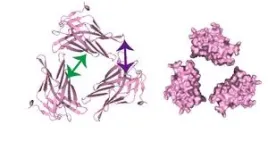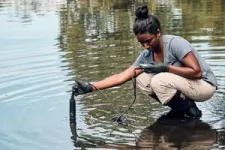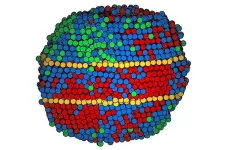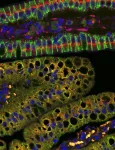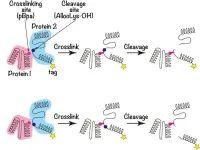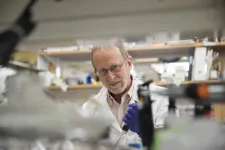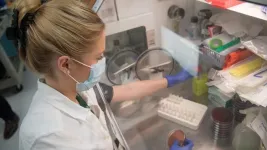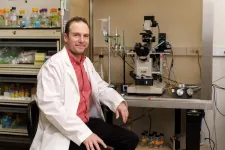(Press-News.org) In less time than it will take you to read this article, an artificial intelligence-driven system was able to autonomously learn about certain Nobel Prize-winning chemical reactions and design a successful laboratory procedure to make them. The AI did all that in just a few minutes — and nailed it on the first try.
"This is the first time that a non-organic intelligence planned, designed and executed this complex reaction that was invented by humans," says Carnegie Mellon University chemist and chemical engineer Gabe Gomes, who led the research team that assembled and tested the AI-based system. They dubbed their creation "Coscientist."
The most complex reactions Coscientist pulled off are known in organic chemistry as palladium-catalyzed cross couplings, which earned its human inventors the 2010 Nobel Prize for chemistry in recognition of the outsize role those reactions came to play in the pharmaceutical development process and other industries that use finicky, carbon-based molecules.
Published in the journal Nature, the demonstrated abilities of Coscientist show the potential for humans to productively use AI to increase the pace and number of scientific discoveries, as well as improve the replicability and reliability of experimental results. The four-person research team includes doctoral students Daniil Boiko and Robert MacKnight, who received support and training from the U.S. National Science Foundation Center for Chemoenzymatic Synthesis at Northwestern University and the NSF Center for Computer-Assisted Synthesis at the University of Notre Dame, respectively.
"Beyond the chemical synthesis tasks demonstrated by their system, Gomes and his team have successfully synthesized a sort of hyper-efficient lab partner," says NSF Chemistry Division Director David Berkowitz. "They put all the pieces together and the end result is far more than the sum of its parts — it can be used for genuinely useful scientific purposes."
Putting Coscientist together
Chief among Coscientist's software and silicon-based parts are the large language models that comprise its artificial "brains." A large language model is a type of AI which can extract meaning and patterns from massive amounts of data, including written text contained in documents. Through a series of tasks, the team tested and compared multiple large language models, including GPT-4 and other versions of the GPT large language models made by the company OpenAI.
Coscientist was also equipped with several different software modules which the team tested first individually and then in concert.
"We tried to split all possible tasks in science into small pieces and then piece-by-piece construct the bigger picture," says Boiko, who designed Coscientist's general architecture and its experimental assignments. "In the end, we brought everything together."
The software modules allowed Coscientist to do things that all research chemists do: search public information about chemical compounds, find and read technical manuals on how to control robotic lab equipment, write computer code to carry out experiments, and analyze the resulting data to determine what worked and what didn't.
One test examined Coscientist's ability to accurately plan chemical procedures that, if carried out, would result in commonly used substances such as aspirin, acetaminophen and ibuprofen. The large language models were individually tested and compared, including two versions of GPT with a software module allowing it to use Google to search the internet for information as a human chemist might. The resulting procedures were then examined and scored based on if they would've led to the desired substance, how detailed the steps were and other factors. Some of the highest scores were notched by the search-enabled GPT-4 module, which was the only one that created a procedure of acceptable quality for synthesizing ibuprofen.
Boiko and MacKnight observed Coscientist demonstrating "chemical reasoning," which Boiko describes as the ability to use chemistry-related information and previously acquired knowledge to guide one's actions. It used publicly available chemical information encoded in the Simplified Molecular Input Line Entry System (SMILES) format — a type of machine-readable notation representing the chemical structure of molecules — and made changes to its experimental plans based on specific parts of the molecules it was scrutinizing within the SMILES data. "This is the best version of chemical reasoning possible," says Boiko.
Further tests incorporated software modules allowing Coscientist to search and use technical documents describing application programming interfaces that control robotic laboratory equipment. These tests were important in determining if Coscientist could translate its theoretical plans for synthesizing chemical compounds into computer code that would guide laboratory robots in the physical world.
Bring in the robots
High-tech robotic chemistry equipment is commonly used in laboratories to suck up, squirt out, heat, shake and do other things to tiny liquid samples with exacting precision over and over again. Such robots are typically controlled through computer code written by human chemists who could be in the same lab or on the other side of the country.
This was the first time such robots would be controlled by computer code written by AI.
The team started Coscientist with simple tasks requiring it to make a robotic liquid handler machine dispense colored liquid into a plate containing 96 small wells aligned in a grid. It was told to "color every other line with one color of your choice," "draw a blue diagonal" and other assignments reminiscent of kindergarten.
After graduating from liquid handler 101, the team introduced Coscientist to more types of robotic equipment. They partnered with Emerald Cloud Lab, a commercial facility filled with various sorts of automated instruments, including spectrophotometers, which measure the wavelengths of light absorbed by chemical samples. Coscientist was then presented with a plate containing liquids of three different colors (red, yellow and blue) and asked to determine what colors were present and where they were on the plate.
Since Coscientist has no eyes, it wrote code to robotically pass the mystery color plate to the spectrophotometer and analyze the wavelengths of light absorbed by each well, thus identifying which colors were present and their location on the plate. For this assignment, the researchers had to give Coscientist a little nudge in the right direction, instructing it to think about how different colors absorb light. The AI did the rest.
Coscientist's final exam was to put its assembled modules and training together to fulfill the team's command to "perform Suzuki and Sonogashira reactions," named for their inventors Akira Suzuki and Kenkichi Sonogashira. Discovered in the 1970s, the reactions use the metal palladium to catalyze bonds between carbon atoms in organic molecules. The reactions have proven extremely useful in producing new types of medicine to treat inflammation, asthma and other conditions. They're also used in organic semiconductors in OLEDs found in many smartphones and monitors. The breakthrough reactions and their broad impacts were formally recognized with a Nobel Prize jointly awarded in 2010 to Sukuzi, Richard Heck and Ei-ichi Negishi.
Of course, Coscientist had never attempted these reactions before. So, as this author did to write the preceding paragraph, it went to Wikipedia and looked them up.
Great power, great responsibility
"For me, the 'eureka' moment was seeing it ask all the right questions," says MacKnight, who designed the software module allowing Coscientist to search technical documentation.
Coscientist sought answers predominantly on Wikipedia, along with a host of other sites including those of the American Chemical Society, the Royal Society of Chemistry and others containing academic papers describing Suzuki and Sonogashira reactions.
In less than four minutes, Coscientist had designed an accurate procedure for producing the required reactions using chemicals provided by the team. When it sought to carry out its procedure in the physical world with robots, it made a mistake in the code it wrote to control a device that heats and shakes liquid samples. Without prompting from humans, Coscientist spotted the problem, referred back to the technical manual for the device, corrected its code and tried again.
The results were contained in a few tiny samples of clear liquid. Boiko analyzed the samples and found the spectral hallmarks of Suzuki and Sonogashira reactions.
Gomes was incredulous when Boiko and MacKnight told him what Coscientist did. "I thought they were pulling my leg," he recalls. "But they were not. They were absolutely not. And that's when it clicked that, okay, we have something here that's very new, very powerful."
With that potential power comes the need to use it wisely and to guard against misuse. Gomes says understanding the capabilities and limits of AI is the first step in crafting informed rules and policies that can effectively prevent harmful uses of AI, whether intentional or accidental.
"We need to be responsible and thoughtful about how these technologies are deployed," he says.
Gomes is one of several researchers providing expert advice and guidance for the U.S. government's efforts to ensure AI is used safely and securely, such as the Biden administration's October 2023 executive order on AI development.
Accelerating discovery, democratizing science
The natural world is practically infinite in its size and complexity, containing untold discoveries just waiting to be found. Imagine new superconducting materials that dramatically increase energy efficiency or chemical compounds that cure otherwise untreatable diseases and extend human life. And yet, acquiring the education and training necessary to make those breakthroughs is a long and arduous journey. Becoming a scientist is hard.
Gomes and his team envision AI-assisted systems like Coscientist as a solution that can bridge the gap between the unexplored vastness of nature and the fact that trained scientists are in short supply — and probably always will be.
Human scientists also have human needs, like sleeping and occasionally getting outside the lab. Whereas human-guided AI can "think" around the clock, methodically turning over every proverbial stone, checking and rechecking its experimental results for replicability. "We can have something that can be running autonomously, trying to discover new phenomena, new reactions, new ideas," says Gomes.
"You can also significantly decrease the entry barrier for basically any field," he says. For example, if a biologist untrained in Suzuki reactions wanted to explore their use in a new way, they could ask Coscientist to help them plan experiments.
"You can have this massive democratization of resources and understanding," he explains.
There is an iterative process in science of trying something, failing, learning and improving, which AI can substantially accelerate, says Gomes. "That on its own will be a dramatic change."
END
Meet 'Coscientist,' your AI lab partner
An AI-based system succeeds in planning and carrying out real-world chemistry experiments, showing the potential to help human scientists make more discoveries, faster.
2023-12-20
ELSE PRESS RELEASES FROM THIS DATE:
3D atomic details of next-generation alloys revealed for first time
2023-12-20
Alloys, which are materials such as steel that are made by combining two or more metallic elements, are among the underpinnings of contemporary life. They are essential for buildings, transportation, appliances and tools — including, very likely, the device you are using to read this story. In applying alloys, engineers have faced an age-old trade-off common in most materials: Alloys that are hard tend to be brittle and break under strain, while those that are flexible under strain tend to dent easily.
Possibilities for sidestepping that trade-off arose about 20 years ago, when researchers first developed medium- and high-entropy alloys, stable materials that combine ...
Catalyzing drug discovery with explainable deep learning
2023-12-20
Scientists have discovered one of the first new classes of antibiotics identified in the past 60 years, and the first discovered leveraging an AI-powered platform built around explainable deep learning.
Published in Nature today, the peer-reviewed paper, entitled “Discovery of a structural class of antibiotics with explainable deep learning,” was co-authored by a team of 21 researchers, led by Felix Wong, Ph.D., co-founder of Integrated Biosciences, and James J. Collins, Ph.D., Termeer Professor of Medical Engineering ...
Study unveils a role of mitochondria in dietary fat processing
2023-12-20
The maintenance of a balanced lipid homeostasis is critical for our health. While consumption of excessive amounts of fatty foods contributes to metabolic diseases such as obesity and atherosclerosis, fat is an indispensable component of our diet. Digested lipids supply the body with essential building blocks and facilitate the absorption of important vitamins. In a new study published in the journal Nature, a team of researchers led by Professor Manolis Pasparakis and their collaborators Professor Aleksandra Trifunovic and Professor Christian Frezza at the Excellence Cluster CECAD of the University of Cologne, and Professor Jörg Heeren ...
Protein secrets unveiled: Newl molecular insight of protein–protein interactions
2023-12-20
Researchers from Tokyo Medical and Dental University (TMDU) have developed a new technique allowing the binding interfaces on two interacting proteins to be characterized, and validated it by describing the homophilic interaction between LAMP2A molecules
Tokyo, Japan – Proteins are building blocks of our bodies, but they do not work solo. They form partners to facilitate in different biological processes that keep us going. However, analyzing how proteins interact at a molecular level can be challenging. Now, a research team from Japan reveals the secrets behind these “protein partnerships”.
In a study published recently in Protein Science, researchers ...
Alzheimer’s discovery reveals dire effect of toxic tau protein on brain cells
2023-12-20
University of Virginia Alzheimer’s researchers have discovered how harmful tau proteins damage the essential operating instructions for our brain cells, a finding which could lead to new treatments.
The toxic protein, the researchers found, warps the shape of the nuclei of nerve cells, or neurons. This alters the function of genes contained inside and reprograms the cells to make more tau.
While the protein has long been a prime suspect in Alzheimer’s and other neurodegenerative “tauopathies,” the new research from UVA’s ...
Fraunhofer USA releases Annual Research Report, Focus 2023
2023-12-20
Fraunhofer USA, a leading nonprofit research organization dedicated to applied research and development services, is proud to announce the release of its Annual Report, Focus 2023. The report underscores Fraunhofer USA's commitment to fostering transatlantic collaboration, strengthening university-government partnerships, and driving impactful technology transfer.
Transatlantic Collaboration: A Pillar of Innovation
In the pursuit of global innovation, Fraunhofer USA continues to play a pivotal role in fostering transatlantic collaboration. The annual report highlights the organization's successful partnerships with Fraunhofer-Gesellschaft research institutes, resulting in groundbreaking ...
International collaboration to improve cancer care in Sub-Saharan Africa updates resources for sixth year
2023-12-20
PLYMOUTH MEETING, PA [December 20, 2023] — The National Comprehensive Cancer Network® (NCCN®)—an alliance of leading academic cancer centers in the United States—is celebrating six years of working alongside the African Cancer Coalition (ACC), the American Cancer Society (ACS), and the Clinton Health Access Initiative (CHAI), as part of Allied Against Cancer. The collaboration was formed to support and empower the Sub-Saharan African oncology community to advance health system capacity, ...
New study sheds light on the connection between the microbiome and kidney stones
2023-12-20
A new study from Lawson Health Research Institute and Western University published in the journal Microbiome has found changes in the microbiome in multiple locations in the body are linked to the formation of kidney stones.
The human microbiome comprises trillions of microorganisms, including healthy bacteria. In recent years, research has begun to uncover its role in health and numerous diseases.
The research team examined the gut, urinary and salivary microbiomes in 83 patients who had kidney stones ...
TTUHSC researcher studies the ability of brine shrimp to thrive in high salinity
2023-12-20
Brine shrimp of the genus Artemia are small crustaceans that can thrive in environments where sodium concentrations are as high as 25% (more than eight times typical ocean sea water). Also known by the household pet trademark ‘sea monkeys,’ these animals are abundant in inland salt lakes where brine-fly larvae are the only other animals known to exist.
The mechanisms which permit brine shrimp to tolerate some of the harshest environments are only partially understood. Previously known adaptive features include a tight protective layer (integument) to avoid water loss and the increased extrusion of sodium (Na+) and chloride (Cl-) ions ...
Digital training program improves quality of life for care residents with dementia – even during the COVID-19 pandemic
2023-12-20
Quality of life for people with dementia living in residential and nursing home care substantially improved after staff took part in a digital training programme that was specially adapted to Covid-19 restrictions. The training also led to a significant drop in the prescription of potentially harmful sedative medications to residents.
The iWHELD programme supported care home staff in delivering personalised care and encouraging meaningful social interactions. Through a digital platform featuring live coaching sessions led by trained coaches, the programme supported ...
LAST 30 PRESS RELEASES:
Superradiant spins show teamwork at the quantum scale
Cleveland Clinic Research links tumor bacteria to immunotherapy resistance in head and neck cancer
First Editorial of 2026: Resisting AI slop
Joint ground- and space-based observations reveal Saturn-mass rogue planet
Inheritable genetic variant offers protection against blood cancer risk and progression
Pigs settled Pacific islands alongside early human voyagers
A Coral reef’s daily pulse reshapes microbes in surrounding waters
EAST Tokamak experiments exceed plasma density limit, offering new approach to fusion ignition
Groundbreaking discovery reveals Africa’s oldest cremation pyre and complex ritual practices
First breathing ‘lung-on-chip’ developed using genetically identical cells
How people moved pigs across the Pacific
Interaction of climate change and human activity and its impact on plant diversity in Qinghai-Tibet plateau
From addressing uncertainty to national strategy: an interpretation of Professor Lim Siong Guan’s views
Clinical trials on AI language model use in digestive healthcare
Scientists improve robotic visual–inertial trajectory localization accuracy using cross-modal interaction and selection techniques
Correlation between cancer cachexia and immune-related adverse events in HCC
Human adipose tissue: a new source for functional organoids
Metro lines double as freight highways during off-peak hours, Beijing study shows
Biomedical functions and applications of nanomaterials in tumor diagnosis and treatment: perspectives from ophthalmic oncology
3D imaging unveils how passivation improves perovskite solar cell performance
Enriching framework Al sites in 8-membered rings of Cu-SSZ-39 zeolite to enhance low-temperature ammonia selective catalytic reduction performance
AI-powered RNA drug development: a new frontier in therapeutics
Decoupling the HOR enhancement on PtRu: Dynamically matching interfacial water to reaction coordinates
Sulfur isn’t poisonous when it synergistically acts with phosphine in olefins hydroformylation
URI researchers uncover molecular mechanisms behind speciation in corals
Chitin based carbon aerogel offers a cleaner way to store thermal energy
Tracing hidden sources of nitrate pollution in rapidly changing rural urban landscapes
Viruses on plastic pollution may quietly accelerate the spread of antibiotic resistance
Three UH Rainbow Babies & Children’s faculty elected to prestigious American Pediatric Society
Tunnel resilience models unveiled to aid post-earthquake recovery
[Press-News.org] Meet 'Coscientist,' your AI lab partnerAn AI-based system succeeds in planning and carrying out real-world chemistry experiments, showing the potential to help human scientists make more discoveries, faster.

